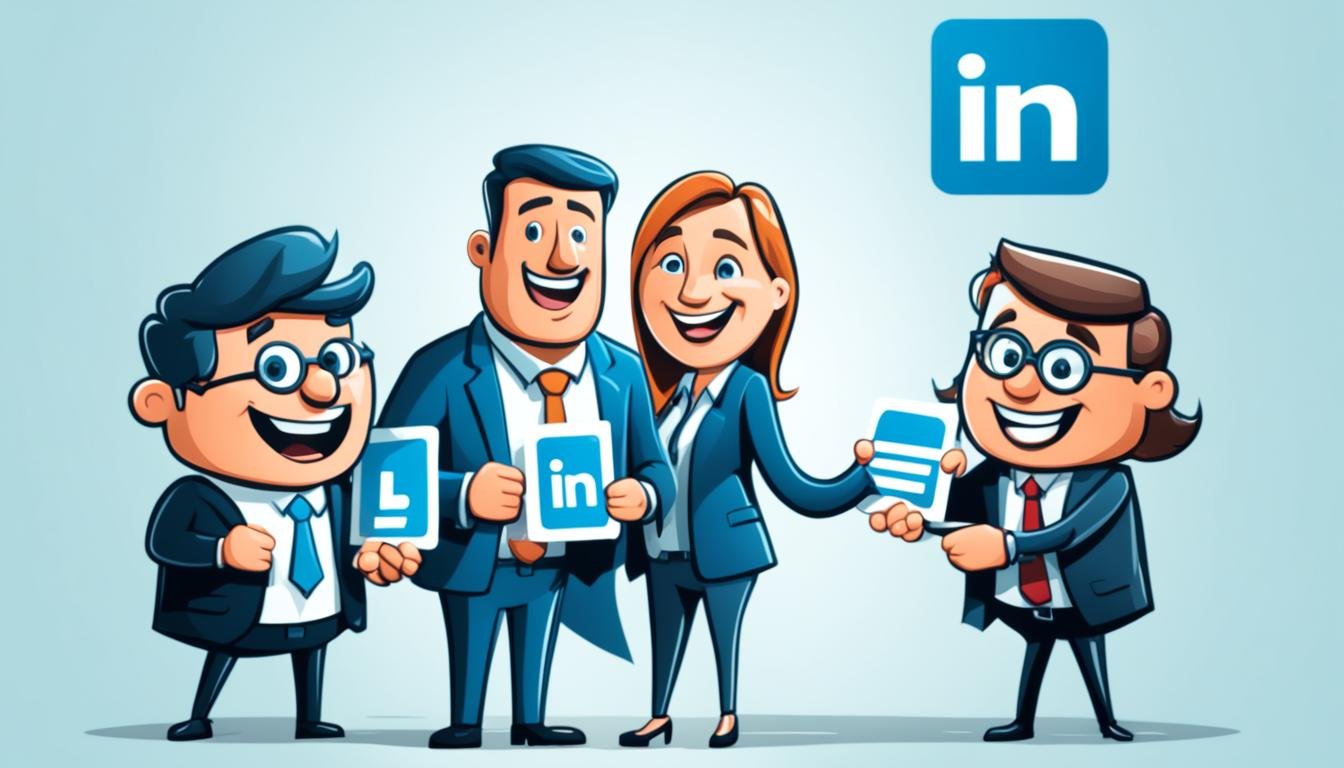LinkedIn for B2B Marketing: Advanced techniques and case studies.
Did you know that about four out of every five LinkedIn users are in charge at their companies? This fact shows why LinkedIn is key for B2B marketers to reach important people in their fields. With over 774 million users and more than 58 million companies, LinkedIn is a goldmine for growing your business.
Stars like Justin Welsh and Vusi Thembekwayo use LinkedIn’s special features to make big impacts in B2B marketing. They turn the platform into a key tool for finding new leads and networking. Whether it’s through regular posts, targeted ads, or live videos, LinkedIn is more than just a place for brands to be seen. It’s a key part of digital marketing.
Key Takeaways
- LinkedIn is vital for B2B marketing because many decision-makers use it.
- Improving your company profile can greatly increase your visibility in searches.
- Sharing content like industry insights and case studies helps build your authority and connect with your audience.
- LinkedIn’s advanced search and ads let you target your audience very precisely.
- Adding LinkedIn to your digital marketing plan can make your marketing more unified and effective.
Understanding LinkedIn for B2B Marketing
LinkedIn is now a key platform for B2B marketing thanks to its professional audience and networking features. It has over 930 million users across more than 200 countries. This makes LinkedIn a crucial tool for businesses targeting key decision-makers. In fact, 80% of LinkedIn users are in decision-making roles, offering a great chance for B2B marketers.
Why LinkedIn is Essential for B2B Marketing
LinkedIn connects businesses with professionals looking for growth and networking opportunities. This makes it a powerful tool for B2B marketing. By using LinkedIn’s advanced strategies, businesses can reach a highly targeted audience. Features like the Matched Audience option and detailed analytics help ensure ads reach the right people, boosting marketing campaign success.
Benefits of Using LinkedIn as a B2B Marketing Tool
LinkedIn offers several benefits for B2B marketing. It allows targeted ads based on job titles, industries, and company sizes. This precision helps focus marketing efforts on the right audience.
LinkedIn also supports thought leadership. Marketing pros can share industry insights through posts and articles. This helps establish them and their companies as leaders in their fields.
LinkedIn’s ad options, like Sponsored Content and Display Ads, let businesses create flexible marketing strategies. These strategies can adapt to the changing needs of B2B marketing.
Advanced LinkedIn strategies can also boost engagement rates. For example, videos on LinkedIn can increase engagement by 5 times. Live videos get 24 times more engagement. Posting during prime hours can also help maximize visibility and interaction.
Using these strategies makes B2B marketing on LinkedIn effective and efficient. It leads to measurable results and helps businesses grow.
Creating an Effective LinkedIn Marketing Strategy
For B2B success, having a strong LinkedIn marketing strategy is key. It’s a great place to build partnerships, get leads, and boost brand awareness. To make the most of LinkedIn, planning and doing well are crucial. We’ll talk about these important parts below.
Defining Clear Objectives
Using LinkedIn well means setting clear goals. You might aim for lead generation, brand recognition, audience engagement, or boosting sales. Knowing who you want to reach, like their job titles, helps make your messages hit home.
For example, understanding what your audience likes to see and interact with can make your messages more effective. This makes your outreach more personal and powerful.
Optimizing Your LinkedIn Profile and Company Page
LinkedIn profile optimization for B2B is vital for marketing success. A complete and engaging company page gets 30% more views each week. Make sure to include details like where you’re located, what you do, who works there, and what you offer.
Using SEO and keywords on your page can attract more leads. Sharing your page on email, blogs, and newsletters can grow your LinkedIn followers and reach.
Consistent and Engaging Content
B2B lead generation on LinkedIn needs consistent, engaging content. A content calendar helps you post regularly and keep up a good flow of updates. Sharing news, case studies, and success stories keeps your audience interested.
Being active in LinkedIn groups related to your field can boost your credibility and draw in leads. Knowing the best times to post and how to post well is key to engaging with B2B audiences. With over 950 million users, LinkedIn is a key spot for B2B marketing.
Integrating LinkedIn into Your Digital Marketing Strategy
LinkedIn is the top professional network, with over 740 million professionals. It’s perfect for B2B marketing because it focuses on professional networking. Using LinkedIn ads can help target specific professional groups. Let’s see how LinkedIn fits well with a wider digital marketing plan.
LinkedIn and Broader Digital Marketing
When LinkedIn works with other digital marketing tools like content marketing and SEO, the results are amazing. Each platform has its own strengths, making marketing efforts more powerful. For example, LinkedIn gives detailed analytics that help improve ad campaigns.
Achieving Cohesive Marketing Results
LinkedIn groups are great for growing professional networks and finding leads. Sharing valuable content on LinkedIn draws in people looking for expert advice. This builds trust in your network. Plus, using the right keywords on LinkedIn makes it easier for people to find you.
Using different types of content like articles and videos keeps things interesting. LinkedIn lets you share longer articles, which can make you seem more credible. Connecting with professionals on LinkedIn can lead to new business chances and partnerships.
LinkedIn is used by 71% of professionals to share business news and offers. For example, Shopify uses LinkedIn to show off its skills and attract subscribers. By linking staff accounts with its main page, Shopify helps build trust and cooperation with potential clients.
Best Practices for B2B Marketing on LinkedIn
LinkedIn is key for B2B marketing, with 774 million users. Posting regularly and engaging with others is vital. This article shares tips to boost your B2B marketing on LinkedIn.
Regular Posting and Engagement
Posting often keeps you visible on LinkedIn. A 2020 study showed that sector-specific content works well. Here are some tips:
- Frequency: Post at least once a week to stay in followers’ feeds.
- Quality: Share content that’s insightful and matches your audience’s interests.
- Engagement: Reply to comments and messages to build trust with potential clients.
LinkedIn is where 71% of professionals look for business advice. So, being active and engaged is key.
Joining and Participating in LinkedIn Groups
Being part of LinkedIn Groups is a smart move for B2B marketing. It lets you show off your expertise and connect with others in your field.
- Select Relevant Groups: Pick groups that match your industry and goals for better interactions.
- Be Active: Share your insights and take part in discussions to gain credibility.
- Network: Connect with group members to grow your network and find new business chances.
Using these strategies, businesses can tap into LinkedIn’s vast professional network. This includes over 58 million companies and many executives making business decisions.
Using LinkedIn for Lead Generation
LinkedIn is a key tool for B2B lead generation. It makes users 6 times more likely to convert after seeing brand messages. It’s the top channel for B2B businesses, offering many ways to draw in and engage potential leads. Let’s look at the main strategies to boost your lead generation on this platform.
Optimizing for Lead Generation
To make LinkedIn work for lead generation, create a strong profile. Use LinkedIn Lead Gen Forms and the platform’s targeting features. These forms make it easy for users to submit information, auto-populating their profile data. They also help drive high-quality leads by making the process smooth.
Being active on LinkedIn is crucial for lead generation. Joining groups and taking part in discussions can really help. The platform lets you target specific groups like job titles, company size, and industries. This makes it easier to find qualified leads.
Combining Organic and Paid Strategies
Using both organic and paid strategies on LinkedIn can lead to great results. Organic methods like content marketing and regular posting are key. LinkedIn’s tools, like LinkedIn Analytics, help you understand your audience and improve your strategy.
Sponsored Content and InMail campaigns can boost your visibility and engagement. Sponsored Content reaches a wider audience, and InMail lets you send personalized messages to leads. Tools like LinkedIn Sales Navigator help find and connect with high-value leads by filtering and outreach.
By using these strategies, B2B businesses can greatly improve their lead generation. Mixing organic and paid methods tailored to your audience is a strong way to use LinkedIn for lead generation.
Optimizing Your LinkedIn Company Page for B2B Success
An optimized LinkedIn Company Page is key for B2B marketing. By focusing on enhancing your company profile and showcasing products, services, and company culture, businesses can increase visibility and engagement. This makes a big difference on the platform.
Enhancing Your Company Profile
First impressions on LinkedIn are crucial. People form opinions about your business in just a few seconds when they visit your page. To make a strong impact, your profile should be professional, well-organized, and detailed. Here are key elements to focus on:
- A custom URL that includes your company name for better search visibility and professionalism.
- A high-resolution profile picture and banner image for a strong visual effect.
- A compelling headline that sums up your business.
- A detailed “About Us” section with 200-250 words to make a lasting first impression.
- Strategically placed calls to action to guide users towards desired actions.
Adding these improvements can greatly enhance your LinkedIn Company Page. This leads to more page views, followers, and impressions. Using relevant keywords throughout your profile also helps you show up more in LinkedIn searches.
Showcasing Products, Services, and Company Culture
Keeping your LinkedIn page fresh with engaging content is crucial for keeping followers interested and refining your brand. Here are some tips:
- Product and Service Highlights: Post detailed descriptions and visuals of your offerings. Use infographics, high-resolution images, and videos to grab attention.
- Company Culture Showcases: Share content that shows off your company’s culture, successes, and events. This makes your brand more relatable and attracts potential clients who value your values.
- Engaging Content Mix: Mix up your content with industry news, company updates, and thought leadership articles. This keeps followers interested and reaches different audience segments.
- Response and Interaction: Answer comments and messages quickly to build stronger connections with your audience.
Using LinkedIn’s lead generation forms can also help capture leads directly from your page. By applying these strategies, businesses can make their LinkedIn Company Page more effective. This leads to better B2B marketing success.
Creating Engaging Content for LinkedIn Marketing
LinkedIn has about 260 million users every month, making it key for professional networking and promoting brands. To get more reach and engagement, it’s vital to share varied and interesting content. Sharing insights and case studies shows your expertise and builds trust with your audience. This is crucial for B2B content marketing success.
Sharing Industry Insights and Case Studies
Sharing industry insights and case studies can boost your LinkedIn marketing. It helps drive engagement and establish your authority. Since 94% of B2B marketers use LinkedIn for sharing content, detailed case studies grab attention. Also, 50% of LinkedIn users are swayed by what they see about companies, showing the impact of good content.
Utilizing a Mix of Text, Images, and Video
Mixing text, images, and video appeals to different tastes and uses LinkedIn’s multimedia features. Short videos are great for sharing business goals and getting more engagement. Infographics, memes, and animated GIFs are fun ways to connect with your audience and showcase your products or services. These formats are perfect for LinkedIn’s interactive vibe, helping you make a big impact.
Companies that use live sessions see more interactions and leads, offering direct ways to connect with followers. With 77% of B2B marketers planning to boost their LinkedIn efforts, creating diverse content is key to doing well.
Posts on LinkedIn without links are more likely to show up in feeds, highlighting the need to optimize your posts. This approach matches the winning strategies of top B2B marketers who see better engagement and conversions.
Leveraging LinkedIn Tools for B2B Business Growth
LinkedIn gives businesses powerful tools to boost marketing and grow B2B. These tools help companies make their strategies better, work more efficiently, and see real success.
Top LinkedIn Tools for Marketing
LinkedIn has many marketing tools to help your B2B efforts. Key tools include sponsored content, sponsored InMail, and text ads. These tools help your content reach the right people in LinkedIn’s huge network of over 774 million professionals.
Companies can connect with decision-makers and potential customers by sharing content like articles, infographics, and videos. This helps them become leaders in their industry and increase engagement.
Using LinkedIn Sales Navigator and Analytics
LinkedIn Sales Navigator and LinkedIn analytics are key for lead generation and analysis. LinkedIn Sales Navigator helps sales people find important decision-makers and build relationships. It also integrates with CRM systems.
LinkedIn analytics gives deep insights into how your LinkedIn Pages and ads are doing. You can see things like impressions, clicks, engagement, and who your audience is. This helps marketers make smart decisions and improve their strategies.
Automating Your LinkedIn Marketing Efforts
LinkedIn marketing automation can change the game for streamlining your work. It can manage tasks like connecting, scheduling posts, and tracking engagement. By using automation and still having personal touch, companies can build strong relationships and communicate well.
This approach saves time and makes sure your LinkedIn marketing is consistent and effective.
Measuring Success on LinkedIn
In the complex world of B2B marketing, it’s crucial to accurately gauge the efficacy of your LinkedIn strategies. Metrics such as engagement rates, follower growth, and lead conversion are key. They help track LinkedIn performance effectively.
Key Metrics to Track
Several key metrics are vital for tracking LinkedIn performance:
- Impressions: The number of times an ad is viewed, vital for evaluating visibility.
- Reach: Unique users impacted, crucial for understanding engagement levels.
- Frequency: Impressions divided by Reach, ideally between 1.5 and 4 to manage exposure.
- Clicks: Indicates user interest and campaign performance.
- CPC (Cost per Click): Assesses ad effectiveness and budget allocation.
- CPM (Cost per Mille): Evaluates cost efficiency per thousand impressions.
- CTR (Click-Through Rate): Measures ad relevance and interest.
- Leads: Counts potential customer generation, reflecting campaign success.
- CPL (Cost per Lead): Determines lead generation efficiency.
- Conversion Rate: Percentage of users who convert after clicking the ad, indicating sales drive effectiveness.
Using Analytics for Continuous Improvement
LinkedIn analytics offers B2B marketers vital insights to improve strategies continually:
- Real-time Experiments: Conducting A/B tests to refine campaigns dynamically.
- Revenue Attribution: Linking marketing efforts to measurable outcomes like sales.
- Audience Verification: Ensuring accurate reach with metrics like MRC accreditation.
- Insight Delivery: Providing data on audience behavior, media planning, and brand analysis.
Understanding and using these metrics helps refine marketing strategies. It also propels the continuous advancement of LinkedIn performance tracking. This leads to significant improvements across campaigns. Embracing these analytics insights ensures marketing teams can fine-tune their efforts. This drives engagement rates and follower growth effectively.
Conclusion
LinkedIn is key for B2B marketing in today’s digital world. It has over 774 million members, making it the biggest professional network site. This makes it vital for B2B marketers to use it well.
LinkedIn helps connect with decision-makers and drive business choices. It also offers deep analytics for campaign success. This makes it a top choice for marketers.
LinkedIn offers many ways to market, like optimizing profiles and creating engaging content. Businesses can use sponsored content, InMail, and ads to reach the right people. Tools like advanced search, analytics, and Sales Navigator help refine marketing strategies.
LinkedIn has tools for every marketing step. Sharing valuable content and engaging with peers in Groups helps build strong relationships. Using lead gen forms and targeted ads can lead to significant growth. By using these strategies, marketers can stay ahead and see great success on LinkedIn.
Source Links
- Advanced LinkedIn strategies for B2B marketing
- Effective LinkedIn Strategies for B2B Marketing Success
- Effective LinkedIn Strategies for B2B Marketing
- The Ultimate Guide To B2B Marketing On LinkedIn
- The Ultimate Guide to Improve Your B2B Content Marketing Strategy
- The Power Of LinkedIn For B2B Marketing
- B2B LinkedIn Marketing Strategy Tips | Clearview Social
- How to Build a LinkedIn Marketing Strategy [Free Template]
- Integrating LinkedIn into Your Overall Digital Marketing Strategy
- How to Use LinkedIn for B2B Marketing Strategy?
- How to Utilize LinkedIn as a B2B Marketing Platform
- The top LinkedIn marketing strategies that actually work for B2B
- How to Generate Leads on LinkedIn in 2024, According to LinkedIn’s VP of Marketing
- Lead Generation for B2B Using LinkedIn
- Lead generation tips, tactics, and best practices | LinkedIn Ads
- Optimizing Your B2B LinkedIn Page for Success
- Optimizing Your B2B LinkedIn Page for Success
- 20 Content Ideas for Most Engaging B2B LinkedIn Posts
- LinkedIn marketing: The complete guide to boost your strategy
- LinkedIn Marketing Tools and Tactics: Leveraging LinkedIn for B2B Success
- Leveraging the Potential of LinkedIn for B2B Marketing
- Solving the 5 Challenges of Modern B2B Marketing Measurement
- LinkedIn B2B success? 10 key metrics to keep in mind
- Global B2B Marketing Benchmark | Download Annual Report
- The importance of LinkedIn for B2B marketing: Why LinkedIn is a critical platform for reaching decision-makers in business
- The Power of LinkedIn in B2B Marketing
- Why You Should Use LinkedIn For B2B Marketing | Dripify





